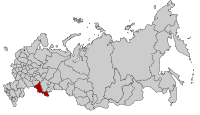Orenburg Oblast
| Orenburg Oblast (English) Оренбургская область (Russian) |
|
|---|---|
 Location of Orenburg Oblast in Russia |
|
| Coat of Arms | Flag |
 Coat of arms of Orenburg Oblast |
 Flag of Orenburg Oblast |
| Anthem: None | |
| Administrative center | Orenburg |
| Established | December 7, 1934 |
| Political status Federal district Economic region |
Oblast Volga Urals |
| Code | 56 |
| Area | |
| Area - Rank within Russia |
124,000 km² 29th |
| Population (as of the 2002 Census) | |
| Population - Rank within Russia - Density - Urban - Rural |
2,179,551 inhabitants 24th 17.6 inhab. / km² 57.8% 42.2% |
| Official language | Russian |
| Government | |
| Governor | Alexey Chernyshyov |
| First Vice-Governor | Sergey Grachyov |
| Legislative body | Legislative Assembly |
| Charter | Charter of Orenburg Oblast |
| Official website | |
| http://www.orb.ru/ | |
Orenburg Oblast (Russian: Оренбу́ргская о́бласть, Orenburgskaya oblast) is a federal subject of Russia (an oblast). Its administrative center is the city of Orenburg.
Contents |
Geography
The most important river of the oblast is the Ural.
Time zone
Orenburg Oblast is located in the Yekaterinburg Time Zone (YEKT/YEKST). UTC offset is +0500 (YEKT)/+0600 (YEKST).
Administrative divisions
Demographics
Population: 2,179,551 (2002 Census);[1] 2,174,459 (1989 Census).[2]
According to the 2002 Census, the national composition of the oblast was as follows:
- Russians: 73.9%
- Tatars: 7.6%
- Kazakhs: 5.8%
- Ukrainians: 3.5%
- Bashkirs: 2.4%
- Mordvinians: 2.4%
- Germans: 0.8%
- Chuvash: 0.8%
- Belarusians: 0.4%
- Azeris: 0.4%
- Uzbeks: 0.2%
- and many other groups, none more than 0.2% of the population.
- 0.13% of the population did not state their nationality in the census.
Religion
The main religion is Orthodox Christianity, while a large minority (about 20%) is Muslim.
Economy
Orenburg Oblast is one of the major agricultural areas of Russia. Its climate is favorable for farming: humid spring, dry summer and a large number of sunny days make perfect conditions for cultivating hard wheat and rye, sunflowers, potatoes, peas, beans, corn, and gourds.
The range of the oblast's export commodities includes: oil and oil products, gas and gas produced products, rolled ferrous and non-ferrous metals, nickel, asbestos, chromium compounds, rough copper, electric engines, radiators, products of machine-building industry.
References
- ↑ Федеральная служба государственной статистики (Federal State Statistics Service) (2004-05-21). "Численность населения России, субъектов Российской Федерации в составе федеральных округов, районов, городских поселений, сельских населённых пунктов – районных центров и сельских населённых пунктов с населением 3 тысячи и более человек (Population of Russia, its federal districts, federal subjects, districts, urban localities, rural localities—administrative centers, and rural localities with population of over 3,000)" (in Russian). Всероссийская перепись населения 2002 года (All-Russia Population Census of 2002). Federal State Statistics Service. Retrieved on 2008-07-25.
- ↑ "Всесоюзная перепись населения 1989 г. Численность наличного населения союзных и автономных республик, автономных областей и округов, краёв, областей, районов, городских поселений и сёл-райцентров. (All Union Population Census of 1989. Present population of union and autonomous republics, autonomous oblasts and okrugs, krais, oblasts, districts, urban settlements, and villages serving as district administrative centers.)" (in Russian). Всесоюзная перепись населения 1989 года (All-Union Population Census of 1989). Demoscope Weekly (website of the Institute of Demographics of the State University—Higher School of Economics (1989). Retrieved on 2007-12-13.
|
||||||||||||||||||||||||||